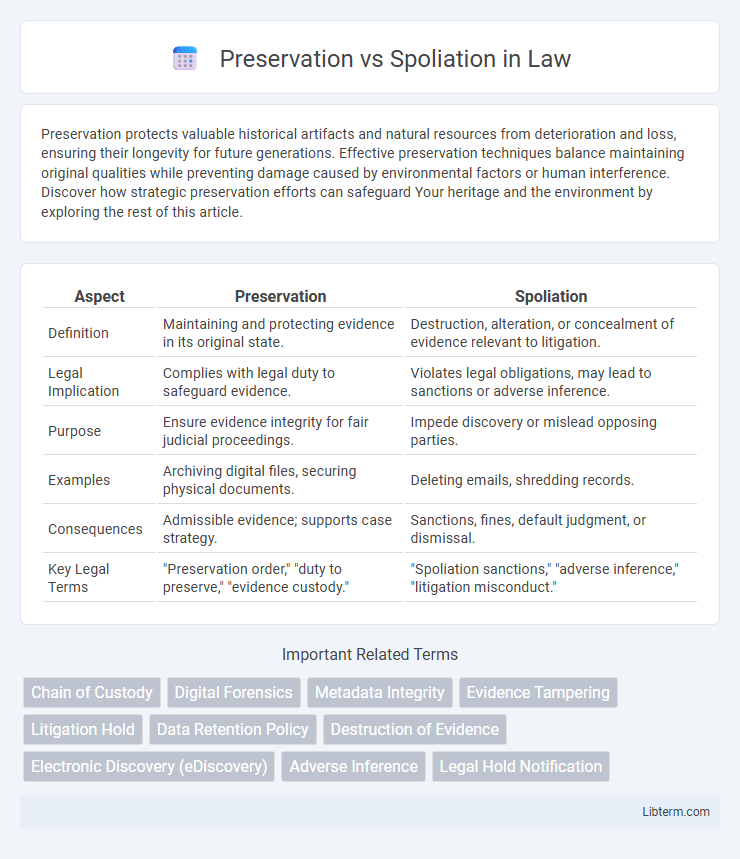Preservation protects valuable historical artifacts and natural resources from deterioration and loss, ensuring their longevity for future generations. Effective preservation techniques balance maintaining original qualities while preventing damage caused by environmental factors or human interference. Discover how strategic preservation efforts can safeguard Your heritage and the environment by exploring the rest of this article.
Table of Comparison
| Aspect | Preservation | Spoliation |
|---|---|---|
| Definition | Maintaining and protecting evidence in its original state. | Destruction, alteration, or concealment of evidence relevant to litigation. |
| Legal Implication | Complies with legal duty to safeguard evidence. | Violates legal obligations, may lead to sanctions or adverse inference. |
| Purpose | Ensure evidence integrity for fair judicial proceedings. | Impede discovery or mislead opposing parties. |
| Examples | Archiving digital files, securing physical documents. | Deleting emails, shredding records. |
| Consequences | Admissible evidence; supports case strategy. | Sanctions, fines, default judgment, or dismissal. |
| Key Legal Terms | "Preservation order," "duty to preserve," "evidence custody." | "Spoliation sanctions," "adverse inference," "litigation misconduct." |
Understanding Preservation and Spoliation
Preservation involves maintaining evidence in its original state to ensure its integrity and availability for legal proceedings. Spoliation refers to the intentional, reckless, or negligent destruction, alteration, or failure to preserve relevant evidence. Understanding these concepts is crucial for compliance with legal obligations and avoiding sanctions in litigation.
Legal Foundations of Evidence Preservation
Legal foundations of evidence preservation are rooted in the duty to maintain the integrity and authenticity of relevant information in anticipation of or during litigation. Preservation obligations arise under rules such as the Federal Rules of Civil Procedure, which require parties to suspend routine data destruction policies once litigation is reasonably anticipated. Failure to preserve evidence, known as spoliation, can lead to sanctions including adverse inference rulings, emphasizing the critical role of timely and adequate preservation measures in the judicial process.
Consequences of Spoliation in Litigation
Spoliation in litigation refers to the intentional destruction or alteration of evidence relevant to a legal case, which can severely undermine the integrity of judicial proceedings. Courts often impose severe consequences for spoliation, including adverse inference instructions, monetary sanctions, or even default judgment against the spoliator, to deter misconduct and preserve fairness. The impact on a party's credibility and the case outcome can be decisive, as spoliation can lead to loss of critical proof that might have supported claims or defenses.
Key Differences Between Preservation and Spoliation
Preservation involves the careful maintenance and protection of digital or physical evidence to ensure its integrity for future legal or investigative needs. Spoliation refers to the intentional or negligent destruction, alteration, or loss of evidence, which can lead to legal penalties and adverse inferences in court. Key differences include the intent behind the action, with preservation aimed at safeguarding evidence, while spoliation undermines the evidentiary value and can compromise the outcome of legal proceedings.
Best Practices for Evidence Preservation
Best practices for evidence preservation emphasize maintaining the integrity and authenticity of data through meticulous collection, secure storage, and detailed documentation. Employing write-blockers during data acquisition and adhering to chain-of-custody protocols ensures evidential reliability in legal proceedings. Regularly updating forensic tools and training personnel in compliance with industry standards further safeguards against accidental spoliation and enhances admissibility.
Identifying Risks of Spoliation
Identifying risks of spoliation involves recognizing potential threats to the integrity and availability of critical evidence, such as data deletion, alteration, or loss during litigation or investigation. Key indicators include inadequate data retention policies, lack of secure backup systems, and employee mishandling or intentional destruction of records. Early risk assessment and implementation of strict preservation protocols are essential to mitigate spoliation and protect evidentiary value.
The Role of Technology in Preservation
Advanced digital tools enhance document preservation by automating data capture, indexing, and secure storage, reducing the risk of spoliation. Cloud-based platforms enable real-time collaboration and audit trails, ensuring the integrity and authenticity of preserved evidence. Artificial intelligence applications improve early identification and classification of relevant data, streamlining compliance with legal obligations in preservation efforts.
Case Studies on Spoliation
Case studies on spoliation reveal crucial patterns where parties intentionally destroy or alter evidence to obstruct justice, often resulting in severe legal consequences such as adverse inference rulings or sanctions. Notable examples include the Zubulake v. UBS Warburg case, where failure to preserve email evidence led to significant penalties and shaped electronic discovery standards. These cases underscore the importance of timely preservation policies and highlight litigation risks when spoliation occurs in both civil and criminal proceedings.
Preservation Orders and Legal Compliance
Preservation orders play a critical role in ensuring legal compliance by mandating the safeguarding of relevant evidence, electronic or physical, during litigation or investigations to prevent spoliation. Failure to comply with preservation orders can lead to severe legal consequences, including sanctions, adverse inferences, and damage to case credibility. Organizations must implement robust data governance policies and audit trails to maintain the integrity and accessibility of preserved evidence throughout the legal process.
Strategies to Prevent Spoliation
Implementing thorough data retention policies and secure, automated backup systems minimizes risks of spoliation by ensuring critical evidence is preserved. Utilizing digital forensics tools alongside regular employee training on legal holds and document management strengthens compliance and reduces the chance of evidence destruction. Prompt identification and isolation of relevant data, combined with clear chain-of-custody procedures, establish robust preventative measures against spoliation in litigation.
Preservation Infographic

 libterm.com
libterm.com